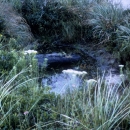About Us
Grasslands
The refuge preserves and maintains one of the best examples of maritime grassland remaining on Long Island. The grassland is dominated by little bluestem, with lesser amounts of Indian grass, poverty grass, and prickly pear cactus. The tidal wetlands provide habitat important for black ducks and a host of other waterbirds. Management activities are geared toward maintaining native grassland, controlling invasive species invasive species
An invasive species is any plant or animal that has spread or been introduced into a new area where they are, or could, cause harm to the environment, economy, or human, animal, or plant health. Their unwelcome presence can destroy ecosystems and cost millions of dollars.
Learn more about invasive species , and protecting habitat.
Maritime grasslands are a globally rare plant community found on outwash plains near oceans or bays. Fewer than 100 maritime grasslands are found worldwide. Since 1989, the State-listed coast flatsedge and bushy rockrose have been recorded at the refuge. Historically, several other listed plants associated with maritime grasslands were known there. The rarity of the maritime grassland habitat type on Long Island is due partly to the rapidity which the vegetation succeeds into maritime shrubland and the absence of disturbance, e.g. fire, to reduce the spread of woody vegetation.
Wetlands
Conscience Point is part of a unique wetland network: the Sebonac Creek/West Neck/Scallop Pond System or, in local vernacular, the Cow Neck Complex. That system encompasses about 300 acres of open water, salt marsh salt marsh
Salt marshes are found in tidal areas near the coast, where freshwater mixes with saltwater.
Learn more about salt marsh , irregularly exposed tidal flats, and aquatic beds. The Cow Neck Complex includes large, privately owned wetlands and wetlands owned by The Nature Conservancy.
The extensive salt and brackish tidal marshes include a number of tidal creeks, ponds and coves. The marshes characteristically comprise low and high marsh areas dominated by smooth cordgrass and saltmeadow cordgrass, respectively, with various admixtures of glasswort, spikegrass, black grass, and sea lavender, among others. Their upland shrubby edges often are dominated by groundselbush, marsh elder and bayberry, grading into upland forest of red maple and white oak.
Our Mission
Vision
Long Island National Wildlife Refuge Complex will preserve, manage, and restore some of the last significant natural areas for wildlife habitat, ranging from coastal systems, to native grasslands to mature forests. These habitats, present in nine distinct units, will support threatened and endangered species in addition to hundreds of species of migratory birds and other wildlife within the Atlantic Flyway.
Located adjacent to the nation’s major media center, the Complex is an ideal setting to increase public awareness, understanding and support of the National Wildlife Refuge System. We recognize that success is dependent on the Complex becoming an integral part of the community. We will work together with partners and local communities to protect priority wildlife-dependent recreational and educational opportunities. Through the use of the best scientific information and active habitat management, we will contribute to the fulfilling of the mission of the National Wildlife Refuge System for future generations.
Refuge Purpose
Each unit of the National Wildlife Refuge System is established to serve a statutory purpose that targets the conservation of native species dependent on its lands and waters. All activities on those acres are reviewed for compatibility with this statutory purpose.
The purpose of Conscience Point is as follows:
- “…for use as an inviolate sanctuary, or for any other management purpose, for migratory birds” (16 U.S.C. §715d).
Other Facilities in this Complex
The Long Island National Wildlife Refuge Complex consists of seven national wildlife refuges, two refuge sub-units and one wildlife management area wildlife management area
For practical purposes, a wildlife management area is synonymous with a national wildlife refuge or a game preserve. There are nine wildlife management areas and one game preserve in the National Wildlife Refuge System.
Learn more about wildlife management area . Collectively, the ten units are approximately 6,500 acres in size. Each unit is unique and provides a wildlife oasis amongst Long Island’s urban settings essential for the livelihood of migratory birds, threatened and endangered species, fish and other wildlife. The strategic location of Long Island in the Long Island Pine Barrens & along the Atlantic Flyway make it an important nesting, wintering and migratory stop over area for hundreds of species of birds.




